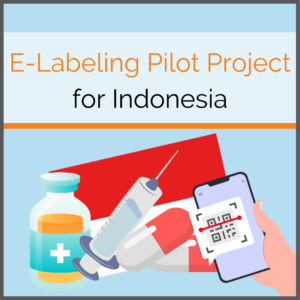
A package insert is an information sheet that accompanies medicines. It contains important information such as the name, active ingredient, dosage, and instructions for use. Possible side effects, contraindications, and interactions with other medications are also listed. Leaflets are of great significance to read before taking medicine to ensure it is used safely and effectively. Generally, a package leaflet is mandatory to allow patients to inform themselves. Recently, a pilot project for e-labeling was launched in Indonesia to digitize the paper leaflet.
The project was approved by decree in September 2023, and implementation began in December of the same year. It is to be tested for two years until November 2025. In this article you can learn about the requirements for e-labeling, the timelines the Indonesian authorities are planning, and the challenges the pilot project poses.
What is e-labeling?
E-labeling refers to the electronic labeling of products. It enables users to retrieve the relevant product information in a machine-readable format. The information is displayed in the form of a barcode in 1D or 2D or using an RFID chip. Users can retrieve this information using a smartphone, scanner, or other device.
Requirements for e-labeling
In the case of the e-labeling pilot project in Indonesia, there are requirements for implementation for two parties. Firstly, the Indonesian health authority BPOM (Badan Pengawas Obat dan Makanan) and secondly, the pharmaceutical industry.
The BPOM is obligated to provide the infrastructure for the project. It includes a place to upload the product information of the labeled medicines. In addition, it provides an app for scanning the e-labels. Finally, it will evaluate the reports on the implementation of the pilot project by the pharmaceutical industry.
The pharmaceutical industry is also held accountable. It is responsible for training the e-label users. They will be required to provide training on how to use the app and general information on the content of the product labels. Furthermore, the project is to be monitored and evaluated every month. As part of this, the industry should ensure that potential risks are mitigated. The result of the evaluation and risk reduction will in turn be submitted as a report to the BPOM. What is included in the e-label is based on the requirements of the Indonesian package leaflet. Product information for use by healthcare personnel is also mandatory here. A medical summary of the benefit-risk profile is required here. The package leaflet must also contain information for patients.
What does the timeline look like?
Two timelines are relevant to the e-labeling project in Indonesia. The legal process from planning to implementation and the two-year project phase is divided into three stages.
- April 2022: A task force for the development of an e-labeling project was formed
- November 2022 to February 2023: The Pharmaceutical Industry Association received a proposal for the pilot project.
- March 2023: The draft decree to implement this pilot project was prepared.
- March to June 2023: Discussion meetings for adjustments to the decree were held.
- June 2023: The Indonesian BPOM sends a confirmation letter to the Pharmaceutical Association, which lists the drugs relevant to the pilot project.
- August 2023: Development and testing of the information system for e-labeling have begun.
- September 2023: Decree No. 317 of 2023 on the implementation of the e-labeling pilot project was published.
- December 2023: The project is active.
The first of the three project phases began with the start of implementation. E-labeling for vaccinations and injections was introduced from December 2023 to February 2024. In this phase, the Indonesian authority limited the number of products to 24. During the second phase from March to May, 54 prescription drugs were added. In the third and final phase, from June 2024 to November 2025, 35 OTC products were added.
Benefits of e-labeling
E-labeling has many benefits. Perhaps the most obvious is the saving of paper. Instead of equipping each package with an instruction leaflet, the information contained in it can be accessed online. Thus, production costs can be reduced and the environment protected. Another point is real-time updates. If there are any changes to the safety instructions or contraindications, it is possible to adapt them quickly. The latest version is always retrieved when the label is scanned. E-labeling can also improve compliance. For example, the digital platforms where the data is stored also contain an audit trail. It ensures transparency and traceability by enabling the authorities to track all revisions. Thus, compliance with documentation and reporting regulations is guaranteed.
Challenges of the pilot project
During the first two phases of the pilot project, several specific challenges have already been identified. For example, it was found that e-labeling has not yet arrived in remote parts of Indonesia. Some medicines with the usual labeling are still in circulation there. Another obstacle could reinforce this problem. Accordingly, parts of the public and many employees in the healthcare sector are not aware of the project. Better information is therefore needed. It has also not yet been possible to make any noticeable savings on printed leaflets and, therefore, production costs. The reason for this, however, is the staggered implementation of the e-labels. As soon as more products are equipped with them, the savings also increase. The BPOM also observed errors when retrieving the medication data. These were related to the scanner app and can be easily resolved over time.
It can be seen that many of the challenges of Indonesia’s e-labeling project are related to the current pilot phase. These are common problems that often occur in beta phases and can be corrected before the actual release. Despite the initial difficulties, the advantages of e-labeling outweigh the disadvantages in the long term. Further implementations of such digitization projects should therefore follow soon.